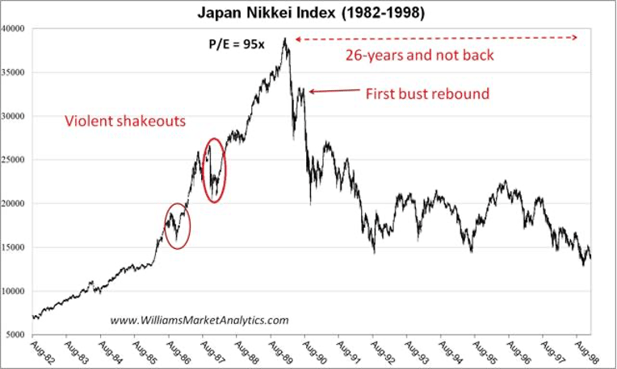When the price of something goes up and up, not because of its intrinsic value, but because people who buy it merely do so with the expectation to be able to sell it again at a profit – what is known as The Greater Fool Theory[1] – that is to say its price is solely determined by speculation and confidence… it never ends well.
When this Greater Fool Theory effect is coupled with a mass infection of confirmation bias – that is investors convince themselves intrinsic value is much higher than it is – financial bubbles tend to follow.
Bitcoin continued to sell off this week down to $35,688 USD currently which is nearly 50% less than its all-time high of $64,863.10 only 6 weeks ago.
We hold the belief it will get a lot lower in the weeks and months to come and here’s why…
The main criticism of cryptocurrency – other than price discovery – is its inadequateness to serve the 3 main purposes of currency
3 properties of currency:
- Store of Value
Maintains its value over time[2]
The speculative forces which underpin cryptocurrency make it probably the most unstable asset we have ever seen. To be an effective store of value a currency’s volatility must be such that it does not cause significant deviations in its purchasing power.
…Strike #1 for BTC
- Unit of Account
A standard unit of numerical measurement of the market value of goods, services & other transactions.[3]
Cryptos do provide a standard unit of measurement, offering exchange rates for USD and other cryptos – however, due to the instability of their prices, it makes the practicality of trading goods and services with cryptocurrency impossible.
Strike #1 and a half
- Medium of exchange
Can be used to intermediate the exchange of goods or services[4]
I do not doubt that blockchain technology has its place to be an effective utility in the future. However, as a currency, it will never replace any of our current reserve currencies until it better serves the aforementioned properties.
So, as we can see the inhibiting factor preventing cryptocurrencies, like bitcoin, from being adopted as world reserve currency stems predominantly from its excessive volatility.
The following needs to take place to suppress crypto volatility:
Targeted Price Range
Let’s use BTC as an example as it pertains to trade: The largest participants in the currency markets are countries and large MNC’s who deal in cross border trade which create a need to exchange one currency for another.
For a company or country to exchange in BTC for their goods or even their own currency, they would need to have confidence in the stability of the BTC to use it as a medium of exchange.
In order to stabilise BTC the supply of BTC will need to be controlled by a central body so that the central body could increase and decrease the supply as needed to stabilise price within a targeted range and give market participants confidence to use BTC as a medium exchange (same can be said as a store of value)
Regulation:
Furthermore, the central body regulating the supply of BTC will need to be an independent body that must not only ensure the price stability of BTC but also must make inflationary considerations when adjusting the supply of BTC.
As oversupplying BTC to the market could lead to inflationary pressures…
Who said Decentralised was a good thing for a currency?
Essentially, BTC rode the curtails of an anti-establishment movement which started with many being disenfranchised and discontent with the accommodating nature with which the central banks bailed out the greedy commercial and investments bank during the GFC.
The genesis block of bitcoin ledger written by Satoshi Nakamoto read: The Times Jan/03/2009 Chancellor on brink of second bailout for banks
The time-stamped quotation of the Times headline and an ode to the quintessence of bitcoin – a decentralised alternative to the current central banking system.
What Satoshi failed to realise is that currency must be centralised so that its supply can be regulated and its price stable for it to be effective.
So, Bitcoin deluders can shout ‘Power to the People’ all they want whilst preaching the benefits of decentralisation but the reality is that decentralisation is the antithesis of an effective currency.
Blockchain – not currency
Blockchain technology and smart contracts are truly innovative as a type of business improvement software. Collaborative technology, such as blockchain, promises the ability to improve the business processes that occur between companies, radically lowering the “cost of trust.”[5]
PwC conducted an explorative dissertation on all its potential uses – found here
Blockchain is the technology which allowed allows cryptocurrencies – like BTC – to exist.
The idea for distributed digital scarcity-based cryptocurrency was genesised in the 1990s by Chinese computer engineer Wei Dei. This idea was refined and some say mastered on 18 august 2008 by Satoshi Nakamoto with the mining of this bitcoin block.
Bitcoin hijacked a good technology with real practical uses in an effort to create money from nothing…and people bought it mistaking increasing price as an indication of successful asset performance.
[1] https://www.investopedia.com/terms/g/greaterfooltheory.asp
[2] http://money.visualcapitalist.com/infographic-the-properties-of-money/
[3] http://money.visualcapitalist.com/infographic-the-properties-of-money/
[4] http://money.visualcapitalist.com/infographic-the-properties-of-money/
[5} https://www.pwc.com/us/en/industries/financial-services/fintech/bitcoin-blockchain-cryptocurrency.html






